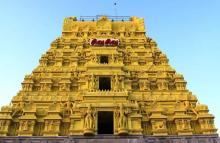
Ramanathaswamy / Rameswaram Temple
The translation of 'Ramanathaswamy' is 'The Master of Rama.' Lord Rama, an incarnation of Lord Vishnu, regarded Lord Shiva as his mentor.
When Lord Rama defeated Ravana, who was a Brahmin, it was seen as a transgression, known as 'Brahma hatya.' To seek redemption for this act, he erected a lingam, which is now enshrined within the temple. This temple holds great significance as a pilgrimage site for Hindu devotees.
One of the Char Dham
Have you heard of the four significant pilgrimage destinations in Hinduism?
They are Kedarnath, Badrinath, Gangotri, and Yamunotri. Additionally, Dwarka, Puri, and Rameswaram are also included in this group. Rameswaram Temple is part of the Char Dham, which holds special sanctity among Hindus. Adi Shankaracharya identified these Dhams as essential pilgrimage sites for Vaishnavite devotees.
Two Lingams - Viswalingam & Ramalingam
When Lord Rama was on his way back from Sri Lanka to Ayodhya, he felt the need to seek forgiveness from the Supreme Lord, Shiva. However, in Rameshwaram, there was no pre-existing statue or idol of Lord Shiva. In response, Lord Rama asked the noble Lord Hanuman ji to bring a sacred statue of Shiva from the Himalayas.
While waiting for Hanuman's return, Mata Sita, out of reverence, fashioned a shrine for Lord Shiva using the sand from the seashore. Subsequently, when Hanuman Ji returned with the Shiva Lingam from the Himalayas, it was installed in the vicinity of the shrine that Lady Sita had prepared.
Therefore, the Ramanathaswamy Temple houses two lingams - the Viswalingam and the Ramalingam. Goddess Sita is credited with the creation of the Ramalingam, while Lord Hanuman is said to have transported the Viswalingam from Kailash, believed to be Lord Shiva's abode, according to mythological accounts.
Sri Ramanathaswamy Temple - History
The ancient Sri Ramanathaswamy temple was originally believed to have existed as a modest thatched hut until the 12th century. It was subsequently reconstructed into a concrete temple by the Sethupathy rulers. The temple underwent significant expansions and renovations between the 12th and 16th centuries under various reigns.
During the 13th century, stone blocks were transported from the Koneswaram temple in Trincomalee to refurbish the sanctum sanctorum of this temple, a project undertaken during the rule of King Jeyaveera Cinkaiariyan. Many kingdoms, including Mysore, Travancore, Pudukottai, Ramanathapuram, and others, also made substantial contributions to the temple's development, resulting in its magnificent structure.
Furthermore, additional enhancements occurred over time, such as the construction of the grand temple corridor in the 18th century. The present structure of the Sri Ramanathaswamy temple, as we see it today, was erected during the 17th century.
Sri Ramanathaswamy Temple - Architecture
The current structure of the Sri Ramanathaswamy temple occupies an expansive 15-acre area of land. Its grand columns, spacious passageways, walls, and towering entrance towers captivate every visitor. Elaborate carvings adorn its granite walls, which are elevated on a platform. This temple is encircled by substantial walls on all four sides, ranging in height from approximately 865 feet to 657 feet.
The outer corridors of the Rameshwaram temple are renowned as the longest in the world, boasting a combined length of 3850 feet for all the corridors. These outer corridors feature approximately 1212 pillars, each standing at a towering height of 30 feet, while the main tower, known as the Rajagopuram, reaches an impressive height of around 53 meters.
The ideal time to visit Rameswaram is from October to March when the temperature is most favorable.
☀️Summer (April to June)
OK
⛈️Monsoon (July to Sep)
OK
❄️Winter (Oct to March)
Best
How To Reach Ramanathaswamy
Below are the options to reach Ramanathaswamy.
✈️ By Air
The closest airport to Rameswaram is Madurai Airport, situated approximately 175 km away. Another option is Thoothukudi Airport, which is approximately 195 km from Rameswaram.
🚝 By Train
Rameswaram boasts a railway station that is conveniently located around 1.3 km from the Ramanathaswamy temple.
🚗 By Road
Rameswaram is well-connected by road and has a bus stand located approximately 2 km from the Ramanathaswamy temple.
Opening Timings of Sri Ramanathaswamy Temple
The Sri Ramanathaswamy Temple, commonly known as the Rameshwaram Temple, welcomes visitors from 5 AM to 1 PM in the morning and reopens for darshan from 3 PM to 9 PM in the evening. This temple is open every day of the week.
In short, All Day Open - 5:00 am – 1:00 pm & 3:00 pm – 9:00 pm

